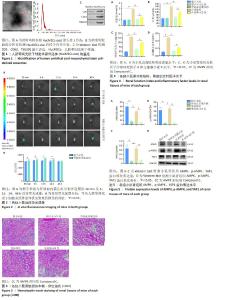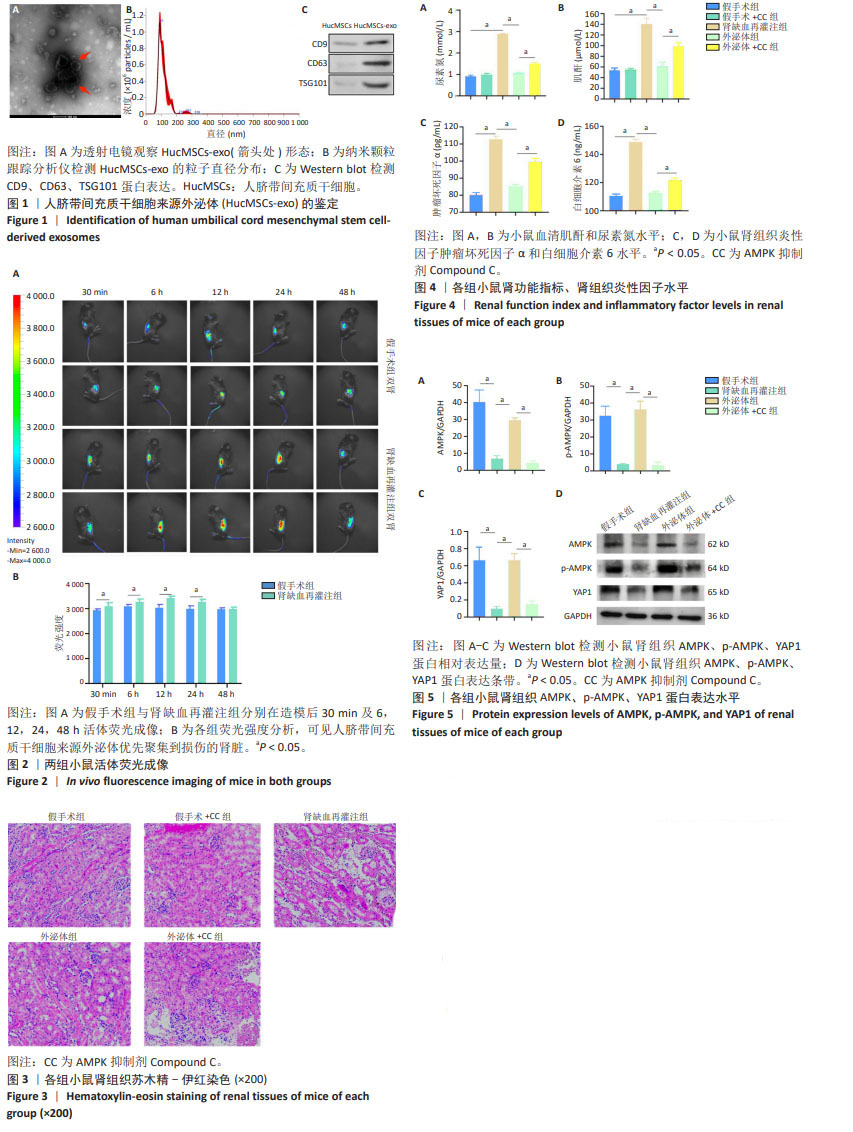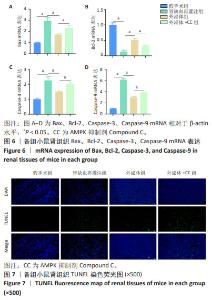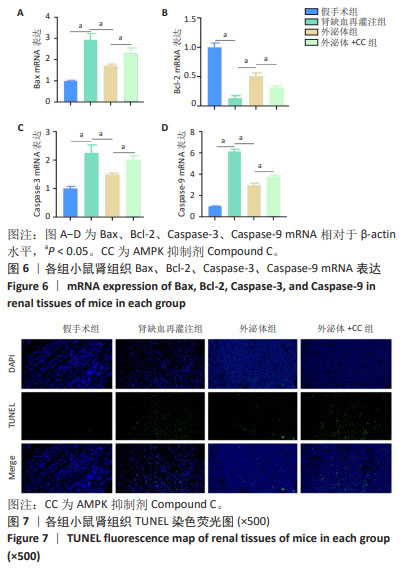Chinese Journal of Tissue Engineering Research ›› 2025, Vol. 29 ›› Issue (13): 2706-2712.doi: 10.12307/2025.048
Previous Articles Next Articles
Mechanism of human umbilical cord mesenchymal stem cell-derived exosomes against mouse renal ischemia/reperfusion injury
Li Lingyu1, Wei Huafeng1, Luo Hao1, Wang Hao2, He Jiahui1, Yao Yawei1, Lyu Xinghua2
- 1First Clinical Medical College of Lanzhou University, Lanzhou 730000, Gansu Province, China; 2Day Surgery Center, The First Hospital of Lanzhou University, Lanzhou 730000, Gansu Province, China
-
Received:2024-01-05Accepted:2024-03-15Online:2025-05-08Published:2024-09-11 -
Contact:Lyu Xinghua, MD, Master’s supervisor, Chief physician, Day Surgery Center, The First Hospital of Lanzhou University, Lanzhou 730000, Gansu Province, China -
About author:Li Lingyu, Master candidate, First Clinical Medical College of Lanzhou University, Lanzhou 730000, Gansu Province, China -
Supported by:Natural Science Foundation of Gansu Province, No. 23JRRA0932 (to LXH); Key Talent Project of Gansu Province, No. 2021RCXM002 (to LXH); Internal Hospital Fund of The First Hospital of Lanzhou University, Nos. ldyyyn2020-106, ldyyyn2022-1 (to LXH); Medical Education Innovation and Development Project of Lanzhou University, No. lzuyxcx-2022-130 (to LXH)
CLC Number:
Cite this article
Li Lingyu, Wei Huafeng, Luo Hao, Wang Hao, He Jiahui, Yao Yawei, Lyu Xinghua. Mechanism of human umbilical cord mesenchymal stem cell-derived exosomes against mouse renal ischemia/reperfusion injury[J]. Chinese Journal of Tissue Engineering Research, 2025, 29(13): 2706-2712.
share this article
Add to citation manager EndNote|Reference Manager|ProCite|BibTeX|RefWorks

2.1 HucMSCs-exo的鉴定结果 透射电子显微镜下,HucMSCs-exos为外泌体典型茶托样结构,见图1A,纳米颗粒跟踪分析结果表明,HucMSCs-exos直径在40-160 nm之间,见图1B。Western blot检测表面蛋白CD9、CD63和TSG101表达呈阳性,见图1C。以上结果表明成功分离得到hucMSCs-exos。 2.2 HucMSCs-exo在小鼠双肾缺血再灌注损伤部位富集 在造模后30 min及6,12,24,48 h肾脏荧光强度见图2A。与假手术组相比,可见在造模后30 min及6,12,24 h肾缺血再灌注组小鼠肾脏荧光强度更强,48 h荧光强度差异无显著性意义,证明外泌体在30 min及6,12,24 h时优先聚集到损伤的肾脏,48 h时外泌体聚集无显著差异,揭示了外泌体聚集的时间特征,见图2B。 2.3 HucMSCs-exo通过AMPK/YAP通路抗小鼠肾缺血再灌注损伤 2.3.1 小鼠肾组织苏木精-伊红染色 与假手术组对比,假手术+CC组小鼠肾组织结构正常,二者之间无明显差异,表明Compound C对小鼠肾无额外损伤;肾缺血再灌注组肾组织结构损伤严重,出现肾小管坏死、扩张,大量炎症细胞浸润和刷状缘消失,病变呈弥漫性改变。给予外泌体后病理改变有所减轻,肾小管管腔部分扩张,肾小管上皮细胞部分刷状缘消失,病变呈局灶性改变;外泌体+CC组小鼠肾组织病理损伤较外泌体组有加重趋势,见图3。 2.3.2 小鼠血清肾功能指标、肾组织炎性因子改变 与假手术组比较,假手术+CC组血清肌酐和尿素氮水平未见明显变化,表明Compound C对小鼠肾功能未造成显著差异损伤;肾缺血再灌注组血清肌酐和尿素氮水平明显升高;与肾缺血再灌注组比较,外泌体组血清肌酐和尿素氮水平明显降低;与外泌体组相比,外泌体+CC组血清肌酐和尿素氮水平增高,见图4A,B。 ELISA检测小鼠肾组织中炎性因子白细胞介素6 和肿瘤坏死因子α水平,由于苏木精-伊红染色与肾功能检测结果表明Compound C对小鼠肾功能未造成显著差异损伤,故后续实验不再检测假手术+CC组。与假手术组比较,肾缺血再灌注组肾组织白细胞介素6和肿瘤坏死因子α水平明显升高;与肾缺血再灌注组比较,外泌体组肾组织白细胞介素6 和肿瘤坏死因子α水平明显降低,与外泌体组相比,外泌体+CC组肾组织白细胞介素6 和肿瘤坏死因子α水平增高,表明HucMSCs-exos对小鼠肾缺血再灌注损伤治疗有效,见图4C,D。 2.3.3 小鼠肾组织AMPK/YAP1通路蛋白表达变化 Western blot 检测显示:与假手术组比较,肾缺血再灌注组肾组织AMPK、p-AMPK、YAP1蛋白表达降低;与肾缺血再灌注组比较,外泌体组肾组织AMPK、p-AMPK、YAP1蛋白表达升高;与外泌体组比,外泌体+CC组肾组织AMPK、p-AMPK、YAP1蛋白表达降低,提示HucMSCs-exos可通过激活AMPK/YAP1通路减轻小鼠缺血再灌注损伤,见图5。"


2.4 HucMSCs-exo通过AMPK/YAP1通路抑制肾组织细胞凋亡抗小鼠肾缺血再灌注损伤 RT-qPCR 检测肾组织凋亡相关因子的表达,结果显示肾缺血再灌注组小鼠肾组织中促凋亡相关标志物Bax、Caspase-3、Caspase-9升高,抑凋亡相关标志物Bcl-2降低;经注射HucMSCs-exos后,促凋亡相关标志物Bax、Caspase-3、Caspase-9降低,抑凋亡相关标志物Bcl-2升高,而进一步注射AMPK抑制剂Compound C后,相对于经外泌体治疗小鼠,促凋亡相关标志物Bax、Caspase-3、Caspase-9升高,抑凋亡相关标志物Bcl-2降低,证明HucMSCs-exos可通过激活AMPK抑制凋亡来减轻缺血再灌注损伤,见图6。 2.5 TUNEL染色观察肾组织细胞凋亡情况 肾缺血再灌注组小鼠肾组织细胞凋亡数量明显增加;外泌体组相较于肾缺血再灌注组细胞凋亡数量减少,而进一步注射AMPK抑制剂Compound C后,肾组织细胞凋亡数量增加,证明HucMSCs-exos可通过激活AMPK抑制细胞凋亡来减轻缺血再灌注损伤,见图7。 "

| [1] BAGHERI A, RADMAN G, ARIA N, et al. The Effects of Quercetin on Apoptosis and Antioxidant Activity in a Renal Ischemia/Reperfusion Injury Animal Model. Drug Res (Stuttg). 2023;73(5):255-262. [2] CHEN J, ZHENG QY, WANG LM, et al. Proteomics reveals defective peroxisomal fatty acid oxidation during the progression of acute kidney injury and repair. Heliyon. 2023;9(7):e18134. [3] TAMMARO A, KERS J, SCANTLEBERY AML, et al. Metabolic Flexibility and Innate Immunity in Renal Ischemia Reperfusion Injury: The Fine Balance Between Adaptive Repair and Tissue Degeneration. Front Immunol. 2020;11:1346. [4] NØRGÅRD MØ, SVENNINGSEN P. Acute Kidney Injury by Ischemia/Reperfusion and Extracellular Vesicles. Int J Mol Sci. 2023;24(20):15312. [5] 贾圣琪,罗文龙,田丁元,等.急性肾缺血再灌注损伤模型小鼠线粒体去乙酰化酶3的表达[J].中国组织工程研究,2023,27(8):1172-1178. [6] STEINBERG GR, HARDIE DG. New insights into activation and function of the AMPK. Nat Rev Mol Cell Biol. 2023;24(4):255-272. [7] CAI J, CHEN X, LIU X, et al. AMPK: The key to ischemia-reperfusion injury. J Cell Physiol. 2022;237(11):4079-4096. [8] CAO S, XIAO H, LI X, et al. AMPK-PINK1/Parkin mediated mitophagy is necessary for alleviating oxidative stress-induced intestinal epithelial barrier damage and mitochondrial energy metabolism dysfunction in IPEC-J2. Antioxidants . 2021;10(12):2010. [9] NOORBAKHSH N, HAYATMOGHADAM B, JAMALI M, et al. The Hippo signaling pathway in leukemia: function, interaction, and carcinogenesis. Cancer Cell Int. 2021;21(1):705. [10] BAILLY C. Pharmacological Properties and Molecular Targets of Alisol Triterpenoids from Alismatis Rhizoma. Biomedicines. 2022;10(8):1945. [11] FENG J, LI H, ZHANG Y, et al. Mammalian STE20-Like Kinase 1 Deletion Alleviates Renal Ischaemia-Reperfusion Injury via Modulating Mitophagy and the AMPK-YAP Signalling Pathway. Cell Physiol Biochem. 2018;51(5):2359-2376. [12] WANG J, CHEN Z, SUN M, et al. Characterization and therapeutic applications of mesenchymal stem cells for regenerative medicine. Tissue Cell. 2020;64:101330. [13] BLONDEEL J, GILBO N, DE BONDT S, et al. Stem cell Derived Extracellular Vesicles to Alleviate ischemia-reperfusion Injury of Transplantable Organs. A Systematic Review. Stem Cell Rev Rep. 2023;19(7):2225-2250. [14] 袁圆,郭文文,王浩,等.人脐带间充质干细胞来源外泌体通过调控SLC7A11/GPX4通路缓解大鼠肾缺血再灌注损伤[J].陆军军医大学学报,2023, 45(11):1173-1180. [15] 郭文文,袁圆,王浩,等.人脐带间充质干细胞来源外泌体在肾缺血一再灌注损伤中的保护作用及其机制研究[J].器官移植,2023,14(3):371-378. [16] CAO JY, WANG B, TANG TT,et al. Exosomal miR-125b-5p deriving from mesenchymal stem cells promotes tubular repair by suppression of p53 in ischemic acute kidney injury. Theranostics. 2021;11(11):5248-5266. [17] ZHANG Y, WANG C, BAI Z, et al. Umbilical Cord Mesenchymal Stem Cell Exosomes Alleviate the Progression of Kidney Failure by Modulating Inflammatory Responses and Oxidative Stress in an Ischemia-Reperfusion Mice Model. J Biomed Nanotechnol. 2021;17(9):1874-1881. [18] DING C, ZHENG J, WANG B, et al. Exosomal MicroRNA-374b-5p From Tubular Epithelial Cells Promoted M1 Macrophages Activation and Worsened Renal Ischemia/Reperfusion Injury. Front Cell Dev Biol. 2020;8:587693. [19] ZHANG Y, WANG J, YANG B, et al. Transfer of MicroRNA-216a-5p From Exosomes Secreted by Human Urine-Derived Stem Cells Reduces Renal Ischemia/Reperfusion Injury. Front Cell Dev Biol. 2020;8:610587. [20] PARK M, KWON CH, HA HK, et al. RNA-Seq identifies condition-specific biological signatures of ischemia-reperfusion injury in the human kidney. BMC Nephrol. 2020;21(Suppl 1):398. [21] CHEN Y, XIONG Y, LUO J, et al. Aldehyde Dehydrogenase 2 Protects the Kidney from Ischemia-Reperfusion Injury by Suppressing the IκBα/NF-κB/IL-17C Pathway. Oxid Med Cell Longev. 2023;2023:2264030. [22] ZHU M, HE J, XU Y, et al. AMPK activation coupling SENP1-Sirt3 axis protects against acute kidney injury. Mol Ther. 2023;31(10):3052-3066. [23] SHAUGHNESSEY EM, KANN SH, CHAREST JL, et al. Human Kidney Proximal Tubule-Microvascular Model Facilitates High-Throughput Analyses of Structural and Functional Effects of Ischemia-Reperfusion Injury. Adv Biol (Weinh). 2024; 8(1):e2300127. [24] WANG W, ZHANG M, REN X, et al. Single-cell dissection of cellular and molecular features underlying mesenchymal stem cell therapy in ischemic acute kidney injury. Mol Ther. 2023;31(10):3067-3083. [25] KALLURI R, LEBLEU VS. The biology, function, and biomedical applications of exosomes. Science. 2020;367(6478):eaau6977. [26] MISSOUM A. Recent Updates on Mesenchymal Stem Cell Based Therapy for Acute Renal Failure. Curr Urol. 2020;13(4):189-199. [27] WANG ZG, HE ZY, LIANG S, et al. Comprehensive proteomic analysis of exosomes derived from human bone marrow, adipose tissue, and umbilical cord mesenchymal stem cells. Stem Cell Res Ther. 2020;11(1):511. [28] YAN Y, MA Z, ZHU J, et al. miR-214 represses mitofusin-2 to promote renal tubular apoptosis in ischemic acute kidney injury. Am J Physiol Renal Physiol. 2020;318(4):F878-F887. [29] YANG BC, KUANG MJ, KANG JY, et al. Human umbilical cord mesenchymal stem cell-derived exosomes act via the miR-1263/Mob1/Hippo signaling pathway to prevent apoptosis in disuse osteoporosis. Biochem Biophys Res Commun. 2020;524(4):883-889. [30] 张曾宇,陈嘉敏,卢圣花,等.苷类中药单体减轻心肌缺血再灌注损伤机制的研究进展[J].实用心脑肺血管病杂志,2023,31(9):115-121. [31] 陈蕾,王雪如,黄杰,等. AMPK介导线粒体融合与裂变在丁苯酞抗小鼠脑缺血/再灌注损伤中的作用[J].中国新药杂志,2022,31(19):1929-1935. [32] ZHOU Q, HE X, ZHAO X, et al. Ginsenoside Rg1 Ameliorates Acute Renal Ischemia/Reperfusion Injury via Upregulating AMPKα1 Expression. Oxid Med Cell Longev. 2022;2022:3737137. [33] HABSHI T, SHELKE V, KALE A,et al. Gaikwad AB. Hippo signaling in acute kidney injury to chronic kidney disease transition: Current understandings and future targets. Drug Discov Today. 2023 ;28(8):103649. [34] ZEYBEK ND, BAYSAL E, BOZDEMIR O, et al. Hippo Signaling: A Stress Response Pathway in Stem Cells. Curr Stem Cell Res Ther. 2021;16(7):824-839. [35] KOO JH, GUAN KL. Interplay between YAP/TAZ and Metabolism. Cell Metab. 2018;28(2):196-206. [36] XING J, WANG Z, XU H, et al. Pak2 inhibition promotes resveratrol-mediated glioblastoma A172 cell apoptosis via modulating the AMPK-YAP signaling pathway. J Cell Physiol. 2020;235(10):6563-6573. [37] BAE SJ, BAK SB, KIM YW. Coordination of AMPK and YAP by Spatholobi Caulis and Procyanidin B2 Provides Antioxidant Effects In Vitro and In Vivo. Int J Mol Sci. 2022;23(22):13730. [38] GRANGE C, TAPPARO M, BRUNO S, et al. Biodistribution of mesenchymal stem cell-derived extracellular vesicles in a model of acute kidney injury monitored by optical imaging. Int J Mol Med. 2014;33(5):1055-1063. [39] TETTA C, DEREGIBUS MC, CAMUSSI G. Stem cells and stem cell-derived extracellular vesicles in acute and chronic kidney diseases: mechanisms of repair. Ann Transl Med. 2020;8(8):570. |
| [1] | Lai Pengyu, Liang Ran, Shen Shan. Tissue engineering technology for repairing temporomandibular joint: problems and challenges [J]. Chinese Journal of Tissue Engineering Research, 2025, 29(在线): 1-9. |
| [2] | Yin Lu, Jiang Chuanfeng, Chen Junjie, Yi Ming, Wang Zihe, Shi Houyin, Wang Guoyou, Shen Huarui. Effect of Complanatoside A on the apoptosis of articular chondrocytes [J]. Chinese Journal of Tissue Engineering Research, 2025, 29(8): 1541-1547. |
| [3] | Jin Kai, Tang Ting, Li Meile, Xie Yuan. Effects of conditioned medium and exosomes of human umbilical cord mesenchymal stem cells on proliferation, migration, invasion, and apoptosis of hepatocellular carcinoma cells [J]. Chinese Journal of Tissue Engineering Research, 2025, 29(7): 1350-1355. |
| [4] | Li Dijun, Jiu Jingwei, Liu Haifeng, Yan Lei, Li Songyan, Wang Bin. Three-dimensional gelatin microspheres loaded human umbilical cord mesenchymal stem cells for chronic tendinopathy repair [J]. Chinese Journal of Tissue Engineering Research, 2025, 29(7): 1356-1362. |
| [5] | Aikepaer · Aierken, Chen Xiaotao, Wufanbieke · Baheti. Osteogenesis-induced exosomes derived from human periodontal ligament stem cells promote osteogenic differentiation of human periodontal ligament stem cells in an inflammatory microenvironment [J]. Chinese Journal of Tissue Engineering Research, 2025, 29(7): 1388-1394. |
| [6] | Wan Lingling, Wu Mengying, Zhang Yujiao, Luo Qingqing. Inflammatory factor interferon-gamma affects migration and apoptosis of human vascular smooth muscle cells through pyroptosis pathway [J]. Chinese Journal of Tissue Engineering Research, 2025, 29(7): 1422-1428. |
| [7] | Lyu Liting, Yu Xia, Zhang Jinmei, Gao Qiaojing, Liu Renfan, Li Meng, Wang Lu. Bibliometric analysis of research process and current situation of brain aging and exosomes [J]. Chinese Journal of Tissue Engineering Research, 2025, 29(7): 1457-1465. |
| [8] | Li Jialin, Zhang Yaodong, Lou Yanru, Yu Yang, Yang Rui. Molecular mechanisms underlying role of mesenchymal stem cell secretome [J]. Chinese Journal of Tissue Engineering Research, 2025, 29(7): 1512-1522. |
| [9] | Cao Yue, Ye Xinjian, Li Biyao, Zhang Yining, Feng Jianying. Effect of extracellular vesicles for diagnosis and therapy of oral squamous cell carcinoma [J]. Chinese Journal of Tissue Engineering Research, 2025, 29(7): 1523-1530. |
| [10] | Liu Zhezhe, Yu Meiqing, Wang Tingting, Zhang Min, Li Baiyan. Troxerutin modulates nuclear factor-kappaB signaling pathway to inhibit brain injury and neuronal apoptosis in cerebral infarction rats [J]. Chinese Journal of Tissue Engineering Research, 2025, 29(6): 1137-1143. |
| [11] | He Guanghui, Yuan Jie, Ke Yanqin, Qiu Xiaoting, Zhang Xiaoling. Hemin regulates mitochondrial pathway of oxidative stress in mouse chondrocytes [J]. Chinese Journal of Tissue Engineering Research, 2025, 29(6): 1183-1191. |
| [12] |
Huang Xiaobin, Ge Jirong, Li Shengqiang, Xie Lihua, Huang Jingwen, He Yanyan, Xue Lipeng.
Mechanisms of different yin nourishing and kidney tonifying methods on osteoclastysis pathway in ovariectomized rats #br#
#br#
[J]. Chinese Journal of Tissue Engineering Research, 2025, 29(6): 1214-1219.
|
| [13] | He Bo, Chen Wen, Ma Suilu, He Zhijun, Song Yuan, Li Jinpeng, Liu Tao, Wei Xiaotao, Wang Weiwei, Xie Jing . Pathogenesis and treatment progress of flap ischemia-reperfusion injury [J]. Chinese Journal of Tissue Engineering Research, 2025, 29(6): 1230-1238. |
| [14] | Xu Fei, Yan Jinqiang, Chai Shoudong. Mechanical stress regulates apoptosis in vascular smooth muscle cells [J]. Chinese Journal of Tissue Engineering Research, 2025, 29(5): 1064-1072. |
| [15] | Lan Shuangli, Xiang Feifan, Deng Guanghui, Xiao Yukun, Yang Yunkang, Liang Jie. Naringin inhibits iron deposition and cell apoptosis in bone tissue of osteoporotic rats [J]. Chinese Journal of Tissue Engineering Research, 2025, 29(5): 888-898. |
| Viewed | ||||||
|
Full text |
|
|||||
|
Abstract |
|
|||||